Amped Wireless R20000G, SR20000G, and UA2000: Routers, Repeaters, and Adapters (Oh My!)
by Jarred Walton on June 23, 2012 12:00 AM EST- Posted in
- wireless
- Networking
- 802.11n
- Amped Wireless
Test Location B Results: Performance at Moderate Distances
Our second test location ramps up the difficulty quite a bit—think Nightmare difficulty in Diablo III. Instead of being located in the same room, right next to the router, we’re now down a hallway, past a bathroom, and into the living room. A direct line from the test area (where my HTPC is located) to the router is around 30 feet, while walking is a slightly longer 40 feet. There are two/three sheetrock walls between the router and Location B, depending on how the signal propagates. You can get an idea of the interior layout of my house from the following (poorly put together) floor plan.
As before, we’ll start with a look at signal quality for this test location. I did spend several minutes (or more) with each adapter trying to orient it such that I got a best-case signal, but once we’re in different rooms the variability between testing runs starts to increase dramatically. As an example, one day I measured one set of results (it was a cooler, cloudy day in Washington), and the next day (sunny and warm) I got results that were 20% lower at the exact same location. It’s a bit maddening to say the least, but short of having a large isolated facility where you can rule out all external forms of interference (e.g. temperature, humidity, and other wireless signals) I’m not sure there’s much to be done about it other than to give the standard “grain of salt” caveat.

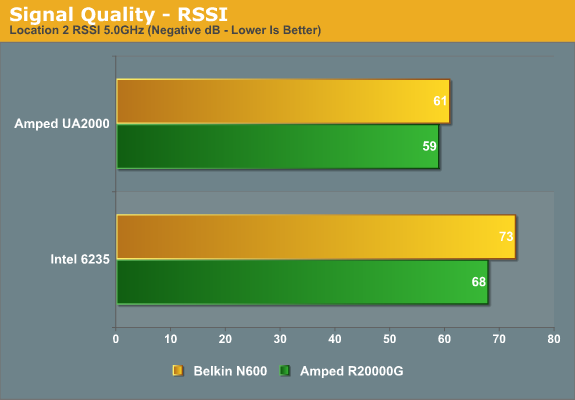
Yet again, Amped delivers on their claims of better signal quality. The R20000G router is 4-12 dB better on the 2.4GHz signal and 2-5 dB better on 5GHz. The UA2000 has similarly large leads, with 3-12 dB better RSSI than the other two adapters. There was at least some correlation between the better RSSI and throughput at Location A; will that hold true with our more demanding test locations? Let’s find out, again starting with the 2.4GHz results.
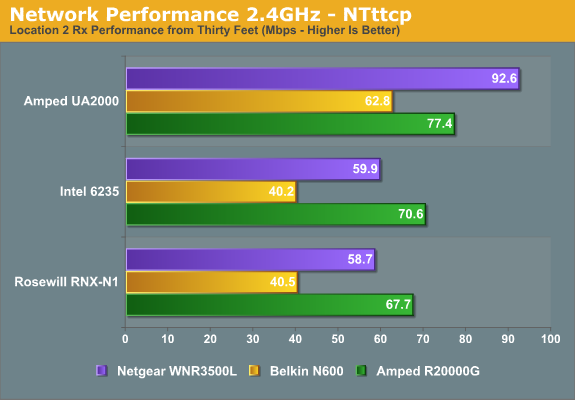
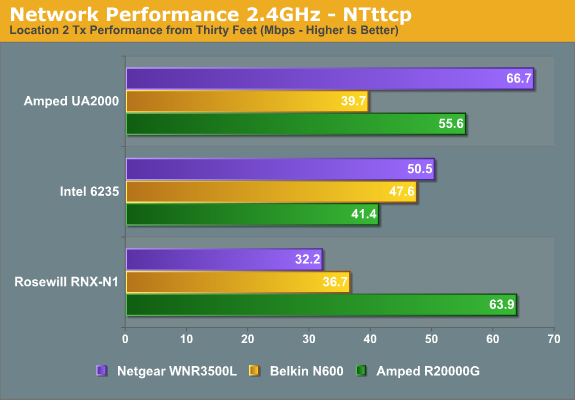
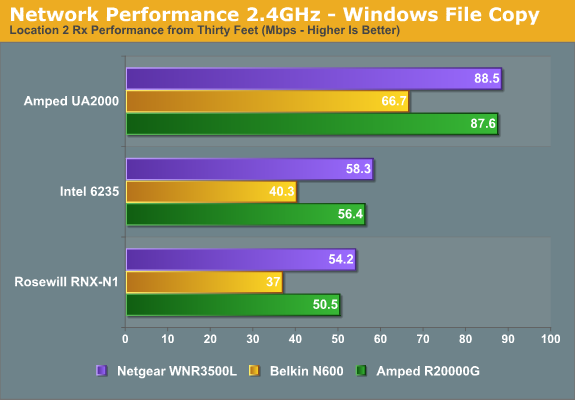
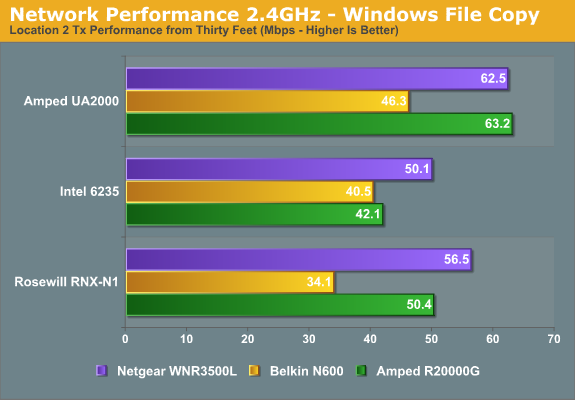
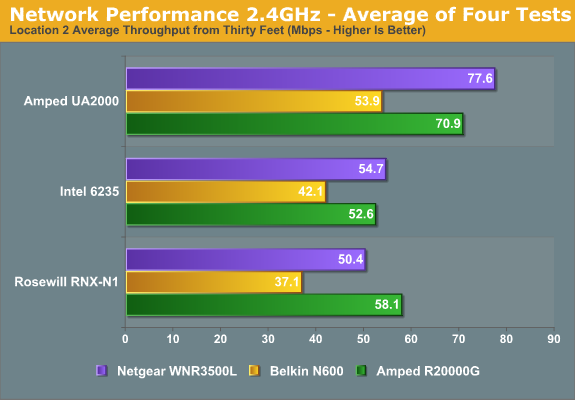
Things get a bit interesting this time around, with some of the adapters performing substantially better when paired with a specific router for some of the tests. Overall, the Netgear router appears to deliver the best throughput in our Rx/Tx file copy results, with the Amped R20000G coming very close. The Belkin router continues to offer substantially lower throughput in most of the charts, with the exception of the NTttcp Tx chart where it places second with two of the adapters. Given the variability of testing at this range, I’d say that the Netgear and Amped routers are more or less equal, and the average throughput across the three adapters agrees with that: the Netgear comes out 1% ahead.
The story for the adapters is far more clear cut, with the UA2000 delivering substantially better throughput than the other two adapters. There’s only one test results (NTttcp Tx) where the UA2000 places second to the Rosewill adapter, and the Windows Copy test doesn’t agree with that result. Average performance with the UA2000 is 35% better than the Intel 6235 across the three routers, and 40% better than the Rosewill RNX-N1. If you have a location with a single PC where you’d rather not run an Ethernet cable, the UA2000 at least approaches 100Mb Ethernet speeds over 2.4GHz wireless.

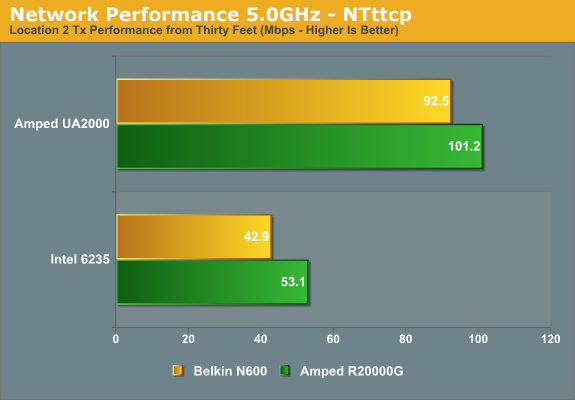
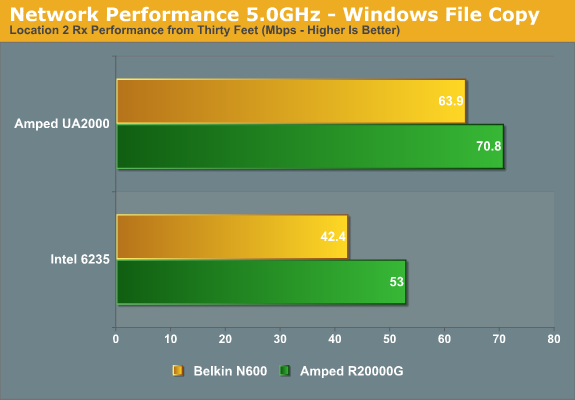
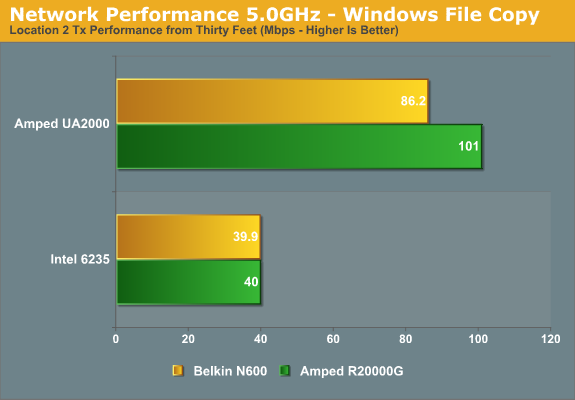

The 5.0GHz results echo the above, only this time the closest we get is a tie in NTttcp Rx rates with the UA2000. For all other comparisons, the R20000G router delivers slightly better performance than the Belkin N600, and the UA2000 adapter basically wipes the floor with the Intel 6235. Of course, directional wireless isn’t nearly as useful in something like a laptop where you’re moving around and unlikely to always end up facing the router, but for stationary PCs you can get excellent performance. On average, the Amped UA2000 is 84% faster than the Intel 6235 while the Amped R20000G is 13% faster than the Belkin N600.


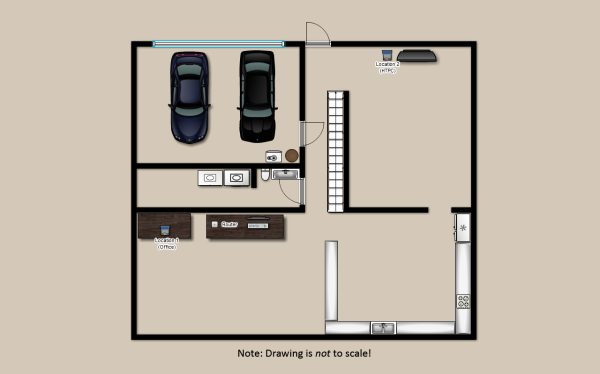








28 Comments
View All Comments
Conficio - Sunday, June 24, 2012 - link
I wonder why Amped Wireless would not combine the repeater and the directional antenna. As Jarred mentioned, for a mobile device a directional antenna is a bit inconvenient, especially if it does easily move.However for a repeater it would be ideal. Place your repeater in a quite weak spot and use the power of the directional antenna to still get a good signal. Then broadcast the repeated signal onmi-directional. That should cut down on the interference too. And a repeater is a heavier object to begin with and stationary. Sure if you don't need it, then you won't need it. But if you have a tricky situation, or simply a very large property (lets say a boats house or an artists shed) then this should be a great solution.
Even better would be to add an additional directional antenna to the main router and the ability to use different channels for the directional link. That could make a point to point link that would cut down on interference even more.
JarredWalton - Sunday, June 24, 2012 - link
I believe Amped does support this, though you'd need to provide the antennas yourself (Amped sells them, though). The only problem is that you'd basically have one antenna directional and pointed at the router with the second omnidirectional, so your total omnidirectional signal strength would likely be limited.Conficio - Monday, June 25, 2012 - link
Thanks Jarred for clarifying this.In my mind that poses one more question, is the directional USB stick a 2x2 config? are both antennas directional? Or is it only one antenna?
But I think you are right, just replacing an antenna with a directional one is not the same as building a real repeter that has a separate notion of (set of) input antenna (directional) and set of output antenna (omnidirectional). Hence there is the opportunity for a company like Amped.
Another question. Is it possible to use only one band (5GHz) to talk to the router and the other band (2.4 GHz) to redistribute? The same for channels? Which should get down the interference even better.
JarredWalton - Monday, June 25, 2012 - link
AFAIK, the UA2000 has both antennas pointing the same direction. It can also pick up other routers that aren't being pointed at, but range and performance drop considerably.As for routing one band to the router and the other for talking to devices, I asked Amped about this, and they said while in theory it's possible to have the repeater send wireless traffic over the other connection (when present), they chose not to do it this way to "keep things simple" or something. If you use a 2.4GHz only router (or disable the 5GHz channel), then 5GHz traffic will get routed over the 2.4GHz radio; likewise, you could disable your router's 2.4GHz channel and have the repeater's 2.4GHz traffic route over 5GHz. That might actually be interesting to test out.
mike8675309 - Tuesday, June 26, 2012 - link
I actually do that in my home. Using DD-WRT I have a WDS network setup with 3 dual radio routers. Clients connect on the 2.4GHz antennas and the routers talk to each other over the 5GHz antennas.PS3, Xbox, Dish DVRs connect with ethernet and get a 5Ghz connection to the internet router, perfect for streaming from Netflix or Dish.
This eliminates the issue with 1/2 the bandwidth when using the same radio to talk to clients as you use for repeating to the main router, which is what is happening for most repeaters in the market.
tlcqualityrentals - Tuesday, July 3, 2012 - link
Lots of great information on this site. If only I could figure out what you guys are talking about. LOL. I had narrowed down my selection to the Amped Wireless R20000g to replace my years 5+ year old Linksys router/modem. The Linksys was fine for my home. I have recently added a cottage and a pavilion to my property. Both are approximately 300 to 400 feet from the Linkysys router. It is imperative that i provide good network coverage in the cottage. My question to you is, how would you solve this issue? What items would you buy?Thanks for any suggestions.
Much appreciated.
Rhonda
bman212121 - Monday, June 25, 2012 - link
One of the biggest issues when trying to pick a wireless AP for range is dechipering through all of the claimed power ratings. I bought an AP that was listed as having a 400mW power rating. I figured that meant that it was a 200mW radio output and 200mW for the 3dbi antennas on it. That is technically true but the issue with N is that those numbers are also divided by the number of antennas you have. So in reality it was 100mW per amp with 100mW (3dbi gain) for each antenna.So in the case of this amped wireless device it would be 125mW (21Db) amps and 5dbi antennas (26dbi EIRP per antenna, making 29dbi total power output) This would make it slightly more powerful than the average home router but for devices where you can replace the antennas you will get more power by having bigger antennas than what is provided on this device.
Case in point, I was floored when our old Linksys WRT54G actually out ranged my 400mw N access point because it used the same 100mw (20Dbm) output and a 2dbi antenna. I'm guessing it must have had a slightly better method of determining the best path and probably a bit more sensitive receiver. I was already planning on swapping the antennas with 9dbi rubber duckies. Once I did that then my AP was able to travel farther however location seems to be far more important for range than anything you can do on the AP side.
GullLars - Sunday, July 8, 2012 - link
"If I had been wise, I would have tabulated all the individual results and come up with a throughput distribution graph (similar to what Brian does with our smartphone Speedtest results), but unfortunately I only considered doing that after the fact. It would also become rather difficult to compare results between routers and adapters using such charts. Still, if there’s enough desire for such testing, I can revisit the subject with a smaller article. Either leave a comment or drop me an email if you’re interested in such testing."Yes, when there are very variable results, using result distribution graphs can give very important information averages leave out, like best and worst case, and consistency of performance.
I'd rather have a wireless connection at average 80Mbps ±10Mbps than average 140Mbps with drops to 40Mbps 10% of the time. Especially if this is also reflected in latency. I'm kinda surprised there were no meassuring of ping, just throughput. Ping and ping spikes are very important for how it feels to use wireless connections.
For most rewiews of IO devices there is mention of both throughput and latency, why not also do this for wireless?